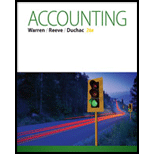
ACCOUNTING,CHAP.1-13
26th Edition
ISBN: 9781305088412
Author: WARREN
Publisher: CENGAGE L
expand_more
expand_more
format_list_bulleted
Question
Chapter 15, Problem 15.3BPE
To determine
Equity investments: Equity investments are stock instruments which claim ownership in the investee company and pay a dividend revenue to the investor company.
Equity method: Equity method is the method used for accounting equity investments which claim a significant influence of above 20% but less than 50% in the outstanding stock of the investee company.
Debit and credit rules:
- Debit an increase in asset account, increase in expense account, decrease in liability account, and decrease in
stockholders’ equity accounts.
- Credit decrease in asset account, increase in revenue account, increase in liability account, and increase in stockholders’ equity accounts.
To journalize: The stock investment transactions for Company Y, under the equity method.
Expert Solution & Answer
Want to see the full answer?
Check out a sample textbook solution
Students have asked these similar questions
What is the dollar value of the ending inventory under variable costing? Of general accounting question please solve and show explanation
On January 1, 2025, Willow Tech Inc. reported a Salaries Payable balance of $39,000. Salaries Expense for 2025 totaled $512,000. The ending balance of Salaries Payable on December 31, 2025, was $46,000. What is the amount of cash paid for salaries in 2025?
Can you please solve this general accounting issue?
Chapter 15 Solutions
ACCOUNTING,CHAP.1-13
Ch. 15 - Why might a business invest cash in temporary...Ch. 15 - What causes a gain or loss on the sale of a bond...Ch. 15 - When is the equity method the appropriate...Ch. 15 - How does the accounting for a dividend received...Ch. 15 - Prob. 5DQCh. 15 - What is the major difference in the accounting for...Ch. 15 - Prob. 7DQCh. 15 - How would a debit balance in Unrealized Gain...Ch. 15 - What are the factors contributing to the trend...Ch. 15 - Prob. 10DQ
Ch. 15 - Prob. 15.1APECh. 15 - Bond investment transactions Journalize the...Ch. 15 - Prob. 15.2APECh. 15 - Stock investment transactions On September 12,...Ch. 15 - Prob. 15.3APECh. 15 - Prob. 15.3BPECh. 15 - Prob. 15.4APECh. 15 - Prob. 15.4BPECh. 15 - Prob. 15.5APECh. 15 - Prob. 15.5BPECh. 15 - Prob. 15.6APECh. 15 - Prob. 15.6BPECh. 15 - Prob. 15.1EXCh. 15 - Prob. 15.2EXCh. 15 - Prob. 15.3EXCh. 15 - Prob. 15.4EXCh. 15 - Prob. 15.5EXCh. 15 - Entries for investment in stock, receipt of...Ch. 15 - Prob. 15.7EXCh. 15 - Prob. 15.8EXCh. 15 - Entries for stock investments, dividends, and sale...Ch. 15 - Prob. 15.10EXCh. 15 - Prob. 15.11EXCh. 15 - Prob. 15.12EXCh. 15 - Prob. 15.13EXCh. 15 - Prob. 15.14EXCh. 15 - Prob. 15.15EXCh. 15 - Prob. 15.16EXCh. 15 - Fair value journal entries, trading investments...Ch. 15 - Prob. 15.18EXCh. 15 - Prob. 15.19EXCh. 15 - Prob. 15.20EXCh. 15 - Prob. 15.21EXCh. 15 - Prob. 15.22EXCh. 15 - Prob. 15.23EXCh. 15 - Prob. 15.24EXCh. 15 - Prob. 15.25EXCh. 15 - Prob. 15.26EXCh. 15 - Prob. 15.27EXCh. 15 - Prob. 15.28EXCh. 15 - Prob. 15.29EXCh. 15 - Prob. 15.1APRCh. 15 - Prob. 15.2APRCh. 15 - Stock Investment transaction, equity method and...Ch. 15 - Prob. 15.4APRCh. 15 - Prob. 15.1BPRCh. 15 - Prob. 15.2BPRCh. 15 - Stock investment transactions, equity method and...Ch. 15 - Prob. 15.4BPRCh. 15 - Selected transactions completed by Equinox...Ch. 15 - Benefits of fair value On July 16, 1998, Wyatt...Ch. 15 - International fair value accounting International...Ch. 15 - Prob. 15.3CPCh. 15 - Warren Buffett and "look-through" earnings...Ch. 15 - Prob. 15.5CP
Knowledge Booster
Similar questions
- General Accountingarrow_forwardMorgan Corp. purchased $600,000 of 8% bonds of Thompson Inc. on January 1, 2022, paying $567,300. The bonds mature January 1, 2032; interest is payable each July 1 and January 1. The discount of $32,700 provides an effective yield of 9%. Morgan Corp. uses the effective-interest method and plans to hold these bonds to maturity. On July 1, 2022, Morgan Corp. should increase its Held-to-Maturity Debt Securities account for the Thompson Inc. bonds by: a. $3,270 b. $1,635 c. $1,529 d. $978arrow_forwardWhat is the cash paid to employees during the year on these financial accounting question?arrow_forward
arrow_back_ios
SEE MORE QUESTIONS
arrow_forward_ios
Recommended textbooks for you
 Intermediate Accounting: Reporting And AnalysisAccountingISBN:9781337788281Author:James M. Wahlen, Jefferson P. Jones, Donald PagachPublisher:Cengage Learning
Intermediate Accounting: Reporting And AnalysisAccountingISBN:9781337788281Author:James M. Wahlen, Jefferson P. Jones, Donald PagachPublisher:Cengage Learning Accounting (Text Only)AccountingISBN:9781285743615Author:Carl Warren, James M. Reeve, Jonathan DuchacPublisher:Cengage Learning
Accounting (Text Only)AccountingISBN:9781285743615Author:Carl Warren, James M. Reeve, Jonathan DuchacPublisher:Cengage Learning College Accounting, Chapters 1-27AccountingISBN:9781337794756Author:HEINTZ, James A.Publisher:Cengage Learning,
College Accounting, Chapters 1-27AccountingISBN:9781337794756Author:HEINTZ, James A.Publisher:Cengage Learning, Corporate Financial AccountingAccountingISBN:9781305653535Author:Carl Warren, James M. Reeve, Jonathan DuchacPublisher:Cengage Learning
Corporate Financial AccountingAccountingISBN:9781305653535Author:Carl Warren, James M. Reeve, Jonathan DuchacPublisher:Cengage Learning College Accounting, Chapters 1-27 (New in Account...AccountingISBN:9781305666160Author:James A. Heintz, Robert W. ParryPublisher:Cengage Learning
College Accounting, Chapters 1-27 (New in Account...AccountingISBN:9781305666160Author:James A. Heintz, Robert W. ParryPublisher:Cengage Learning

Intermediate Accounting: Reporting And Analysis
Accounting
ISBN:9781337788281
Author:James M. Wahlen, Jefferson P. Jones, Donald Pagach
Publisher:Cengage Learning

Accounting (Text Only)
Accounting
ISBN:9781285743615
Author:Carl Warren, James M. Reeve, Jonathan Duchac
Publisher:Cengage Learning

College Accounting, Chapters 1-27
Accounting
ISBN:9781337794756
Author:HEINTZ, James A.
Publisher:Cengage Learning,

Corporate Financial Accounting
Accounting
ISBN:9781305653535
Author:Carl Warren, James M. Reeve, Jonathan Duchac
Publisher:Cengage Learning


College Accounting, Chapters 1-27 (New in Account...
Accounting
ISBN:9781305666160
Author:James A. Heintz, Robert W. Parry
Publisher:Cengage Learning